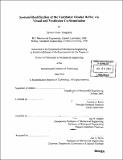System identification of the vestibular ocular reflex via visual and vestibular co-stimulation
Author(s)
Tangorra, James Louis, 1967-
DownloadFull printable version (57.72Mb)
Other Contributors
Massachusetts Institute of Technology. Dept. of Mechanical Engineering.
Advisor
Lynette A. Jones.
Terms of use
Metadata
Show full item recordAbstract
The study of eye motions involved in the vestibular ocular reflex (VOR) is a key tool for understanding the performance of the vestibular system and for the diagnosis of dysfunction. Limitations in experimental equipment and in the analytic methods applied have resulted in VOR testing being conducted under artificial laboratory conditions that do not resemble the conditions under which the VOR naturally functions. The results from these tests are often unreliable, and may, in fact, misrepresent the function and performance of the VOR and the vestibular system. The purpose of this thesis was to develop the experimental equipment, protocol, and analysis algorithms required to conduct a stochastic system identification of the horizontal, rotational VOR, while it was being used to stabilize gaze during natural, head-free tracking. By providing statistically uncorrelated stimuli to the visual and vestibular systems, estimates of the VOR's impulse response function could be made as subjects tracked a visual target that moved with an unpredictable trajectory. A novel stochastic technique was developed to generate the visual and vestibular input sequences such that they had appropriate amplitude distributions, and auto- and cross-correlation functions. The results showed that the technique was able to identify the dynamics of the VOR over the frequency range that it naturally functions to stabilize gaze, that is from below 0.5 Hz through 4.0 Hz. Nonlinearities in the head-neck control system limited the analysis at low frequencies, and difficulties in calculating high frequency eye velocities limited the accuracy of the analysis at high frequencies. (cont.) Unlike the rotational VOR tests that are commonly used today, this technique was able to distinguish between the visually and vestibularly driven eye responses, and was able to show that during head-free gaze tracking, the vestibular system is able to compensate for head disturbances with a near unity gain.
Description
Thesis (Ph. D.)--Massachusetts Institute of Technology, Dept. of Mechanical Engineering, 2003. Includes bibliographical references (p. 317-321).
Date issued
2003Department
Massachusetts Institute of Technology. Department of Mechanical EngineeringPublisher
Massachusetts Institute of Technology
Keywords
Mechanical Engineering.